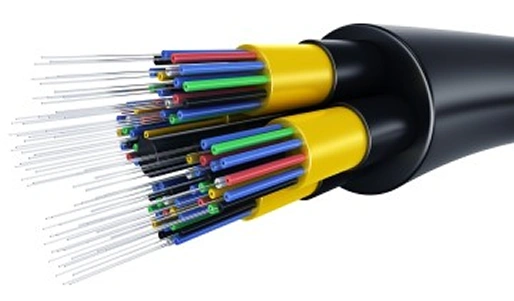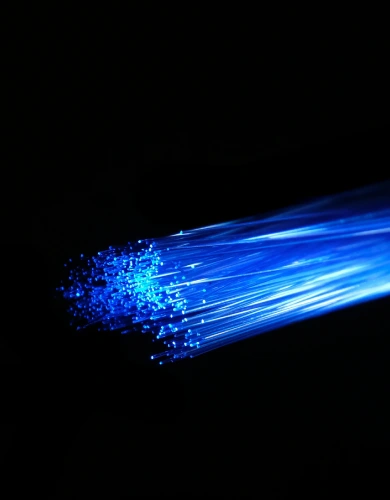How fibre optic broadband works
Fibre optic technology has transformed the UK’s internet infrastructure, delivering faster, more reliable, and higher-capacity broadband.
Without the fibre optic revolution, remote working, video conferencing, and streaming services like Netflix would not have been possible.
This guide explains the use of fibre optic broadband technology in the UK. Here’s what it covers:
- How does fibre optic broadband work?
- Types of fibre optic broadband
- FTTP vs FTTC
- Fibre optic broadband performance
- Fibre optic broadband installation
- Fibre optic network providers
How does fibre optic broadband work?
To best explain how fibre optic broadband works, it’s helpful first to understand what an internet connection actually is.
All internet activities, such as using a VoIP phone system, watching a YouTube video, or sending and receiving emails, require data transfer between your device and the wider internet.
In a fibre optic broadband connection, data is transmitted using light signals within a fibre optic cable.

At the centre of the cable is a thin strand of glass, approximately the diameter of a human hair.
A laser sends data as a series of light flashes at one end of the fibre optic cable. These light signals travel along the cable by repeatedly reflecting off the walls of the glass fibre.
Light travels approximately 125 miles per second in glass, making fibre optic cables the fastest and lowest latency type of broadband connection available in the UK.
At the end of the fibre optic cable, an Optical Network Terminal (ONT) converts incoming light signals back into standard ethernet signals. These can be wired directly into devices or connected wirelessly using a business broadband router.
Fibre optics verses copper cables
The best way to understand fibre optic broadband technology is by comparing it to what came before.
Before the introduction of fibre optic broadband in 2010, ADSL broadband was widely used by homes and businesses in the UK.
ADSL broadband relies on the UK’s Openreach copper-wire landline network to transmit broadband data.
Fibre optic cables offer a superior method for transmitting broadband data packets compared with copper telephone cables because:
- Light signals travel much faster through glass than electrical signals through copper, significantly reducing latency.
- Light signals support a wider range of frequencies, enabling a higher rate of data throughput on a single fibre and increasing connection speed.
- Light signals experience significantly less signal degradation than electrical signals through copper, ensuring more consistent performance.
Fibre optic technology is so clearly superior to ADSL that the copper-based landline network is being shut down in 2027 as part of the big switch off.
Types of fibre optic broadband
The table below displays the most common domestic and business fibre optic broadband connection types in the UK.
| Type | Fibre optic connection | Speed | Cost | UK Availability |
|---|---|---|---|---|
| Leased Line | Dedicated fibre optic line for a single business, connecting directly to an exchange. | Up to 10 Gbps | Very high | Universal* |
| Full Fibre | A Fibre-to-the-Premises (FTTP) connection where a fibre cable connects a property directly to the nearest cabinet. The connection between the cabinet and exchange is shared with other properties in the area. | Up to 1 Gbps | Moderate to high | 72% |
| Cable | High-performance coaxial cable connects a property to the nearest cabinet (FTTC). The connection between the cabinet and exchange is shared with other properties in the area. | Up to 1 Gbps | Moderate to high | 60% |
| Part Fibre / SoGEA | A Fibre-to-the-Cabinet (FTTC) connection with a copper landline cable connecting a property to the nearest cabinet. The connection between the cabinet and exchange is shared with other properties in the area. | Up to 80 Mbps | Moderate | 97% |
We’ve included leased line broadband as a universal coverage option in the table. With a leased line, a dedicated fibre optic cable is installed from the nearest exchange. Although this could be done anywhere, it can be prohibitively expensive in some rural areas.
We have excluded niche fibre optic connection types like GFast, which are no longer available to UK businesses.
FTTP vs FTTC
Two acronyms, FTTP and FTTC, describe fibre optic connection types. Both refer to how individual premises are connected to the nearest Openreach cabinet.
- Fibre-to-the-Premises (FTTP): A dedicated fibre optic cable connects a premise directly to the cabinet. This is typically advertised as Full Fibre Business Broadband.
- Fibre-to-the-Cabinet (FTTC): A copper phone line connects a premise to the cabinet. This is typically advertised as part fibre, standard fibre, or SoGEA broadband.
The key difference lies in the performance of the cable in the “last mile” of the broadband connection. A copper phone line has a maximum bandwidth of 80 Mbps, severely limiting the speed of an FTTC connection.
A full fibre connection, using fibre optic cable technology, delivers superior performance in all metrics. The only limiting factor is coverage, as businesses outside towns and cities may not yet have access to full fibre broadband.
If full fibre is not yet available in your location, we recommend signing up for Openreach’s automatic alerts to be notified when the infrastructure in your area is upgraded as part of their full fibre roll-out.
Fibre optic broadband performance
Fibre optic technology makes broadband fast, reliable, and secure. We explain the key performance advantages of fibre optic broadband in this section.
Fibre optic broadband speed
Long-distance fibre optic cables can support extremely high speeds with minimal loss and interference.
In June 2024, a laboratory in Japan recorded a speed of 402 terabits per second, 5 million times faster than the average broadband speed in the UK.
The data transfer efficiency in a fibre optic cable is much greater than that of radio waves used by 5G business broadband or satellite business broadband.
The maximum business broadband speeds on widely available leased line connections is 10 Gbps.
Fibre optic broadband reliability
Fibre optic broadband connections are the most reliable form of broadband available in the UK.
Fibre broadband offers three key advantages that contribute to its high reliability:
- Light signals in fibre optic cables are immune to electromagnetic and radio interference.
- Unlike copper cables, fibre optic cables do not corrode over time.
- Fibre optic cables maintain signal strength over long distances, reducing reliance on signal amplification equipment.
For more information, refer to our full article on business broadband reliability.
Fibre optic broadband security
Fibre optic broadband has intrinsic characteristics, making it more secure than copper or wireless connections.
The light signals traversing fibre optic cables are encrypted and require specialised equipment to decode. Furthermore, any attempt to tap into fibre optic cables causes a noticeable disruption in the light signals, making unauthorised access easily detectable.
For more information, refer to our full article on business broadband cyber security.
Fibre optic broadband installation
The process required for a business broadband installation depends on the technology used for the connection.
Here’s a summary of what is typically involved:
- Part fibre: Typically, no installation is required as it relies on existing copper landline connections already installed in most properties.
- Cable/Full Fibre: When first used, this option requires the installation of a new cable between the local cabinet and the individual property.
- Leased line: Installing a dedicated fibre optic cable from an exchange to the property is always required. For more information, read our guide on leased line installations.
Fibre network providers
In the UK, businesses and homes can choose from hundreds of competing broadband providers.
These domestic and business broadband providers rely on a small number of fibre optic network providers to manage the physical infrastructure.
The biggest fibre network providers in the UK are:
- Openreach (part of the BT group)
- City Fibre
- Virgin Media
- CommunityFibre
- Hyperoptic
Source: ISP Review network coverage.
These are further supported by regional fibre networks such as KCOM.
Find out more in our full guide to business broadband availability.

